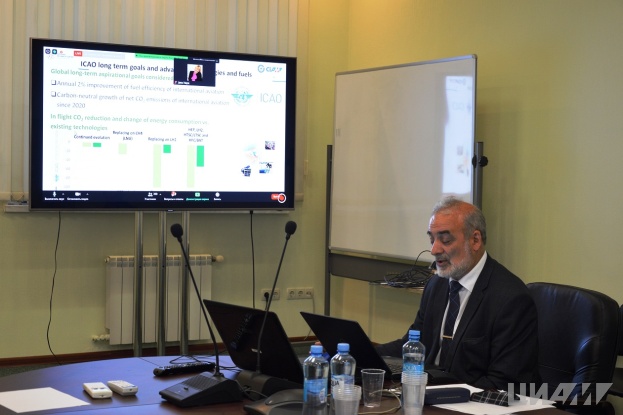CIAM took part in ICAO Stocktaking Seminar

‘Green’ aviation became one of the main topics of the ICAO Stocktaking Seminar on aviation in-sector CO2 emissions reductions held virtually on 8-11 September 2020. The online event was attended by around 1200 participants.
The specialists of the National Research Center “Zhukovsky Institute” and the Central Institute of Aviation Motors (CIAM, a part of the National Research Center “Zhukovsky Institute”) were among them.
The experts shared their plans and discussed roadmaps to decarbonizing and enhancing the effectiveness of the civil air transport.
The Seminar’s high-level roundtables featured the main challenges related to achieving the long-term ICAO goals: scaling up aviation biofuels and ‘green’ hydrogen and decreasing their costs, costs of changes in airport infrastructure connected with the transition to hydrogen fuel, lack of a regulatory framework for certification of advanced aircraft and their propulsion systems, etc.
Key research on the way to ‘green’ aviation is associated with providing solutions to the questions of emissions reductions, advanced and novel aircraft technologies, sustainable fuels, operational improvements both in the air and on the ground. A growing number of countries develop hybrid and electric propulsion systems, which can potentially not only improve the fuel efficiency of future aircraft, but also enhance their environmental performance.
The National Research Center “Zhukovsky Institute” and CIAM presented at the event a joint report on the Russia’s experience of using hydrogen in civil aviation.
In 1988, the USSR was the first country to confirm the reality of using an alternative fuel (liquid hydrogen) on a ‘civil size’ Tu-155 aircraft. A flight test cycle was performed then, which made it possible to master a number of new technologies, such as: hydrogen purification, its transportation, refueling, draining, on-board-storage, pressure control in the tank, fuel supply to the engine, etc. CIAM then initiated the use of hydrogen in aviation and developed an industry-specific standard for its use.
The report of the Russian experts provided a brief overview of the advantages and disadvantages of alternative fuels: cryogenic methane, LNG, liquid hydrogen. According to the authors, the most effective reduction of harmful emissions from aircraft-in-flight can be achieved through a consistent development of breakthrough technologies with their testing on demonstrator engines: from conventional hybrid propulsion for small aircraft (planned 25 per cent CO2 reduction) to hybrid or fully electric propulsion with hydrogen fuel cells, electrical machinery with the use of high temperature superconductivity, fueled by liquid hydrogen (planned 75-100 per cent CO2 reduction).
As known, in June 2020, EASA certified the first fully electric aircraft Pipistrel Velis Electro and its electric propulsion system according to special certification conditions.
The Russian experts noted in their report that international certification rules for electric aircraft and fuels are extremely needed.
In their view, such rules must be linked with additional requirements for urban transport noise, life cycle assessment emission factor specific to hydrogen, hydrogen fuel properties, safety of electric units, batteries and boundary layer ingestion system, etc.
As an outcome of the ICAO Stoctaking event, a package of proposals of promising technologies was formed, information on which will be used by the Long-term Global Aspirational Goal Task Group (LTAGTG) of the ICAO Committee on Aviation Environmental Protection (CAEP). The CAEP-LTAGTG task group was created in 2020 to provide technical support in the exploration of the feasibility of a long-term global aspirational goal for international civil aviation CO2 emissions reductions, including options and roadmaps for their realization.
On the photo: Representative of Russia in CAEP, CIAM's head of sector Arthur Mirzoyan delivering the joint report at the ICAO Stocktaking Seminar.
 Eng
Eng Rus
Rus